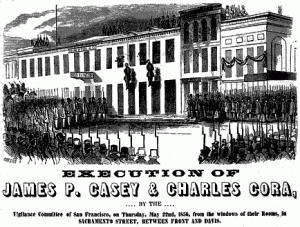05.15
On this date in 1856, angered by the shooting of a prominent journalist, San Franciscans form their second vigilance committee to combat lawlessness. The need for vigilance committees in San Francisco was obvious. Only two years after gold was discovered at Sutter’s Mill in 1848, San Francisco had grown from a sleepy little village with 900 inhabitants to a booming metropolis with more than 200,000 residents. The sudden influx of people overwhelmed the city. Harried law enforcement officials found it nearly impossible to maintain law and order, and chaos was common in the streets, which were lined with saloons and gambling parlors. Attracted by the promise of gold, marauding bands of Australian criminals called “Sydney ducks” robbed and extorted the people of San Francisco with near impunity.
San Franciscans formed their first vigilance committee in 1851. About 200 vigilantes enrolled, most of them from the elite professional and merchant class of the city. They had headquarters along Battery Street, where they could temporarily imprison criminals, and the ringing of the city’s fire bell would summon the vigilantes to action. A handful of men who were found guilty of serious crimes like murder were hanged from a nearby derrick normally used to haul freight into the second story of a warehouse. More commonly, though, the vigilantes simply deported criminals like the “Sydney ducks” back to their homelands.
Whether due to the vigilante actions or because conventional law enforcement became more effective, things eventually quieted down in San Francisco and the first vigilance committee disbanded. In 1856, however, a rigged election put an Irish-Catholic politician named James P. Casey on the city board of supervisors. James King, a crusading editor of the Daily Evening Bulletin, accused Casey of being involved in criminal activity in the city. On May 14, 1856, Casey confronted King in the street and fatally wounded him with a Colt navy revolver. The next day, angry San Franciscans created the second vigilance committee. This time, however, they could not claim that the city government was not enforcing the law–the sheriff had already arrested Casey and put him in the county jail pending trial. Acting more like a raging mob than an instrument of justice, 500 vigilantes surrounded the county jail and removed Casey from the sheriff’s custody on May 18. After a short but reasonably fair trial, they hanged him.
Some historians have argued that the second vigilance committee was less interested in suppressing crime than in attacking its political enemies. Casey’s election signaled a shift in power to the dominant faction of recently immigrated Irish-Catholic Democrats. The vigilantes, who were largely native-born Protestants, reasserted their control by arresting and exiling their political opponents from the city. As before, they hanged several men. Regardless of the vigilantes’ true motives, a number of Irish Catholic leaders did leave the city and the Protestant elite managed to regain control of the government. Late in 1856, the vigilance committee formally disbanded and never again became active.












